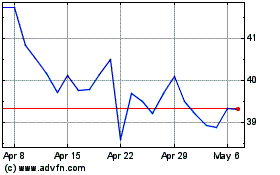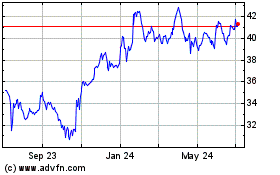By Sarah Krouse
Verizon Communications Inc.'s new chief executive, Hans
Vestberg, has taken the helm as the wireless giant pursues a bet
that providing a strong network is better than trying to own the
content that flows through it.
Verizon plans to roll out the next, faster generation of
wireless networks, or 5G, for its residential customers in four
cities before the end of the year. The service uses
higher-frequency spectrum known as millimeter waves, which can
carry more data than other types of spectrum but can't travel as
far or penetrate many hard materials.
The company has thus far opted not to pursue the
transformational mergers and acquisitions like AT&T Inc.'s
purchase of Time Warner or T-Mobile US Inc.'s proposed purchase of
Sprint Corp. In an interview, Mr. Vestberg, who was CEO of Ericsson
AB before joining Verizon in 2017, discusses what 5G will mean for
consumers and why providing the pipes is the best position for the
telecom carrier to be in. Edited excerpts follow:
WSJ: What differences will consumers see with 5G?
MR. VESTBERG: 5G has eight different currencies. The currency is
something I can give to a consumer or enterprise, things like the
peak data rate, the mobile data volumes, the mobility -- or how
fast can you drive and still keep the signal. Other currencies
include network reliability, latency [which is the speed at which
two devices communicate], and how many connected devices you can
have per square kilometer. With 4G, you can have roughly 1,000
connected devices per square kilometer. It is one million on 5G.
There also is the energy efficiency and service deployment time, or
how long it takes to connect to the internet.
WSJ: What does that mean for, say, a home?
MR. VESTBERG: There will be lots of connected devices in homes
in the future, such as smart refrigerators, cameras and tablets. We
can handle more of them from a 5G mobile network because of its
capacity.
Today with 4G, you can have 200 milliseconds on the network in
latency; with 5G, that will go down to 10 milliseconds. What can
you do with 10 milliseconds? You can have intense online gaming
that is totally mobile. You can have [retail-store] transactions on
mobile phones on the mobile network. You wouldn't do that on 4G
today. You would sit at a fixed location with a fiber straight to a
computer.
WSJ: When will consumers understand 5G, given the lag time
between building networks and compatible devices coming to
market?
MR. VESTBERG: They will understand it when they have a 5G phone
in their hands.
We have announced that we will have one 5G product from Motorola
coming out early next year. It is a chipset that can be clipped to
an existing phone to make it compatible with a 5G network. It is
much quicker to build that than a new 5G-compatible phone.
WSJ: One of your rivals said there is no point in investing in
5G technology until there are real-world applications for it.
MR. VESTBERG: This is the same thing we heard before 4G came to
market. Everyone was screaming, "What's the use case? Why do we
need it?" The phones came and then bam! The innovation came from
Silicon Valley.
Use cases for business will include things like a cordless
factory, where robots are operated remotely, without cords. We have
consumer groups working with application developers. We have a
small and medium size business group, an enterprise group talking
to enterprise customers, an Internet of Things group. We're
building the networks at the same time.
WSJ: Do you feel comfortable that rain, leaves, a FedEx truck
aren't going to disrupt 5G service?
MR. VESTBERG: Yes, yes, yes.
WSJ: Is video the main application of 5G for in-home broadband?
You recently announced partnerships with Apple TV and Google's
YouTube TV for your 5G residential broadband customers.
MR. VESTBERG: What do you need the bandwidth for in your home?
Usually it's entertainment, but you can do other things as well. If
you have the speeds and Wi-Fi at home, you're probably going to do
a hundred other things as well. You can have security cameras,
virtual-reality learning, smart-home products like thermostats and
lighting. These things can't operate at the same time reliably
today, but with 5G they can.
WSJ: How will 5G affect Oath, Verizon's digital media and
advertising unit that includes properties such as Yahoo Finance,
HuffPost and Tumblr?
MR. VESTBERG: They are working a lot with media and
entertainment. They are working on virtual reality/augmented
reality. We have Ryot, one of the most advanced digital studios in
the world. We are working with them -- what can they do with their
assets in the 5G world?
WSJ: Will people pay for it? What's the path to monetizing 5G
for the consumer?
MR. VESTBERG: You have to be innovative here. There are going to
be more connected devices, so the number of things you can and will
connect is going to grow, and presumably there will be some revenue
associated with that.
WSJ: Does the unlimited phone plan continue in a 5G world?
MR. VESTBERG: We haven't gotten that far. We aren't sharing our
commercial plans from a confidential point of view.
WSJ: As a network provider, how do you benefit from the success
of an application like Uber? If a customer uses an unlimited plan
to summon their Uber, what's the incremental economic benefit you
get?
MR. VESTBERG: Overall, if there are no applications, you don't
need a network and vice versa. Applications won't come unless they
have a network that can support them, and networks lead to more
experimentation and the development of apps. We have created such a
fantastic network that people can innovate on -- that's our best
asset.
WSJ: So you're confident you will recoup the investment in the
network?
MR. VESTBERG: You would invest in the network anyhow. You need
to be leading on technology. We are in the business of delivering
data and speeds and throughputs for our customers, so if we aren't
investing in the latest technology, we are going to be at a
disadvantage.
WSJ: Do you see China as ahead of the U.S. in rolling out 5G,
and does it matter?
MR. VESTBERG: No, I don't see it. We've already announced that
we are rolling out 5G in four cities this year. I haven't heard
that it will be rolled out in any cities in China this year.
WSJ: Is there a threat that tension between Washington and
Beijing potentially scuttles any piece of your business or progress
on 5G?
MR. VESTBERG: No. I don't see that.
WSJ: You've been clear that you have the assets you want. Are
you concerned about the heavy investment required to roll out a 5G
network and that it might take a while to actually see the
benefits?
MR. VESTBERG: We have places where we want to provide network
connectivity only. There are some services Verizon can provide --
we have a connected-car product called Hum, for example -- and
others where we need a partner. In some areas we will provide
connectivity, a device that brings Wi-Fi into the home, but Apple
and YouTube will provide the content. I can work with anyone to get
maximum usage of what I would say is the best network.
Ms. Krouse is a reporter for The Wall Street Journal in New
York. Email sarah.krouse@wsj.com.
(END) Dow Jones Newswires
September 11, 2018 10:00 ET (14:00 GMT)
Copyright (c) 2018 Dow Jones & Company, Inc.
Verizon Communications (NYSE:VZ)
Historical Stock Chart
From Mar 2024 to Apr 2024

Verizon Communications (NYSE:VZ)
Historical Stock Chart
From Apr 2023 to Apr 2024
